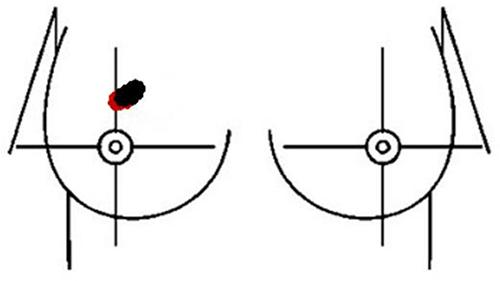Figures & data
Table 1 Patients’ Demographic and Pathological Information Along with the Type of Surgery Performed as the Re-Excision Procedure
Figure 1 Example of positive inferior margin defined as positive nipple-ward margin for a lesion at 12:00.

Figure 2 (A) Frontal view of the breast highlighting the cancer (black mass) at 12’o clock in relation to the nipple with inferior margin positive (yellow) demonstrating cancer spread in the nipple-ward direction. (B) A lateral view of the breast highlighting the tumor (black mass) at 12 o’clock with a positive inferior margin (yellow) illustrating cancer spread in the nipple-ward direction.

Table 2 Nipple-Ward Margin Stratification

